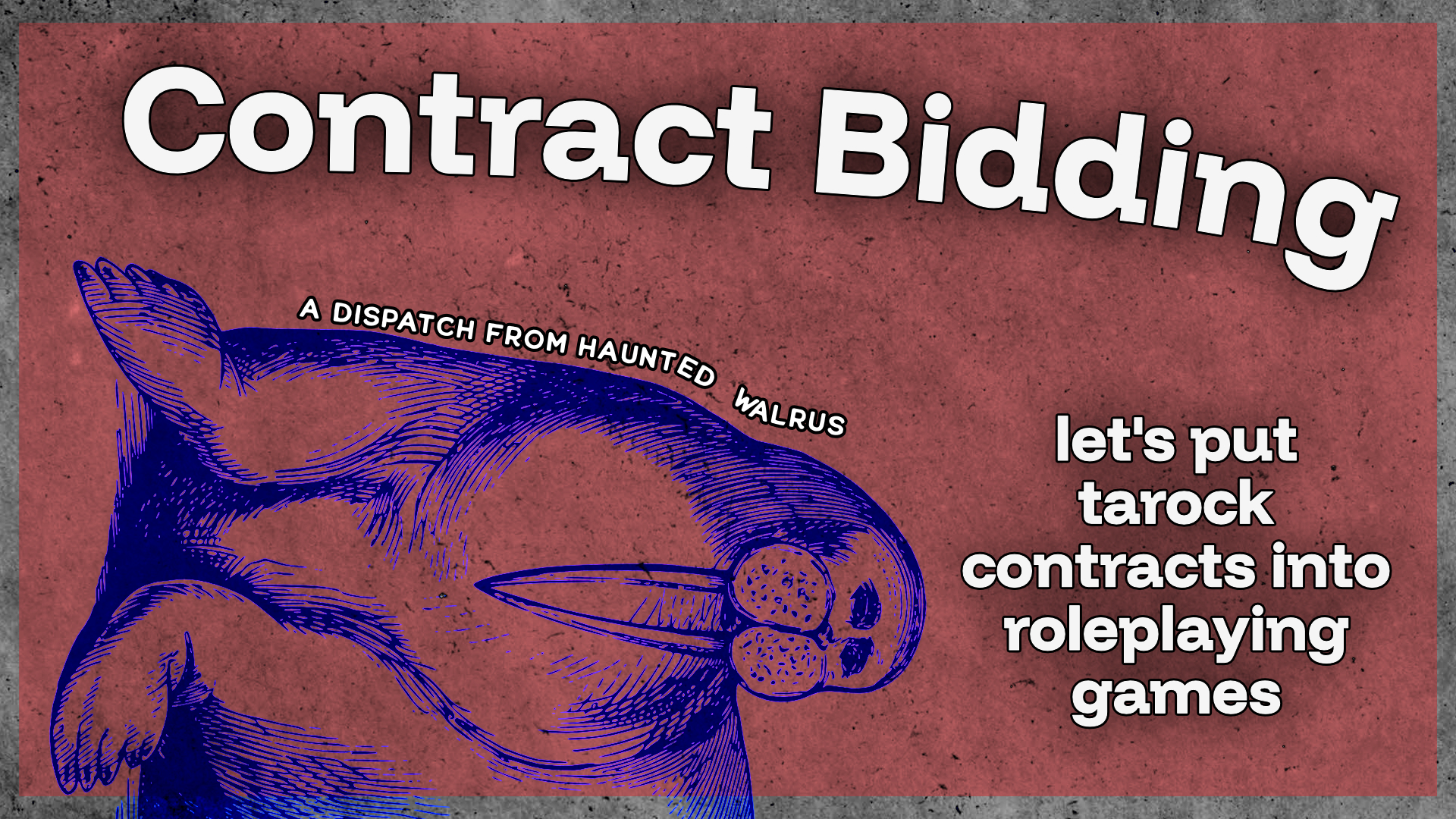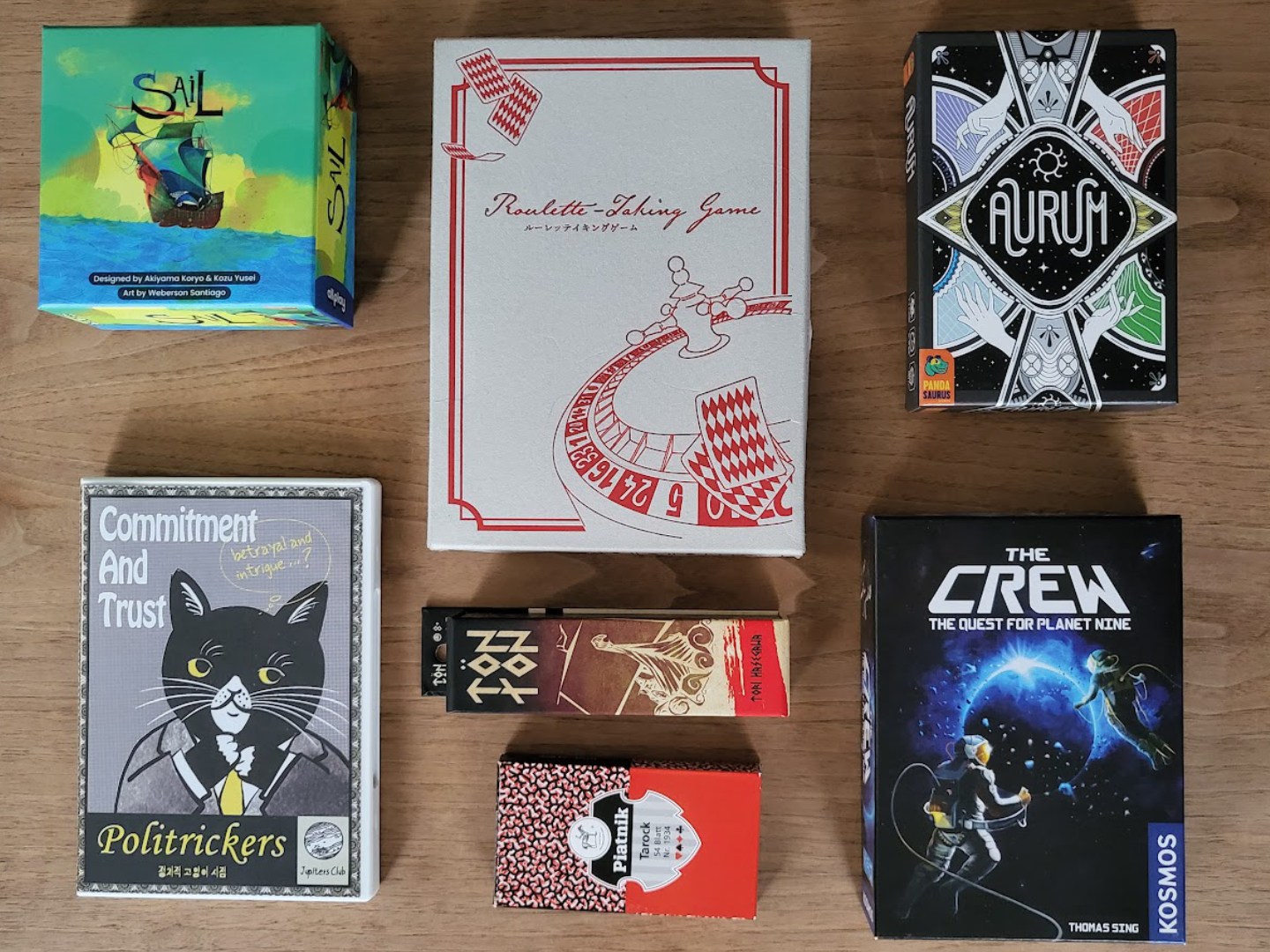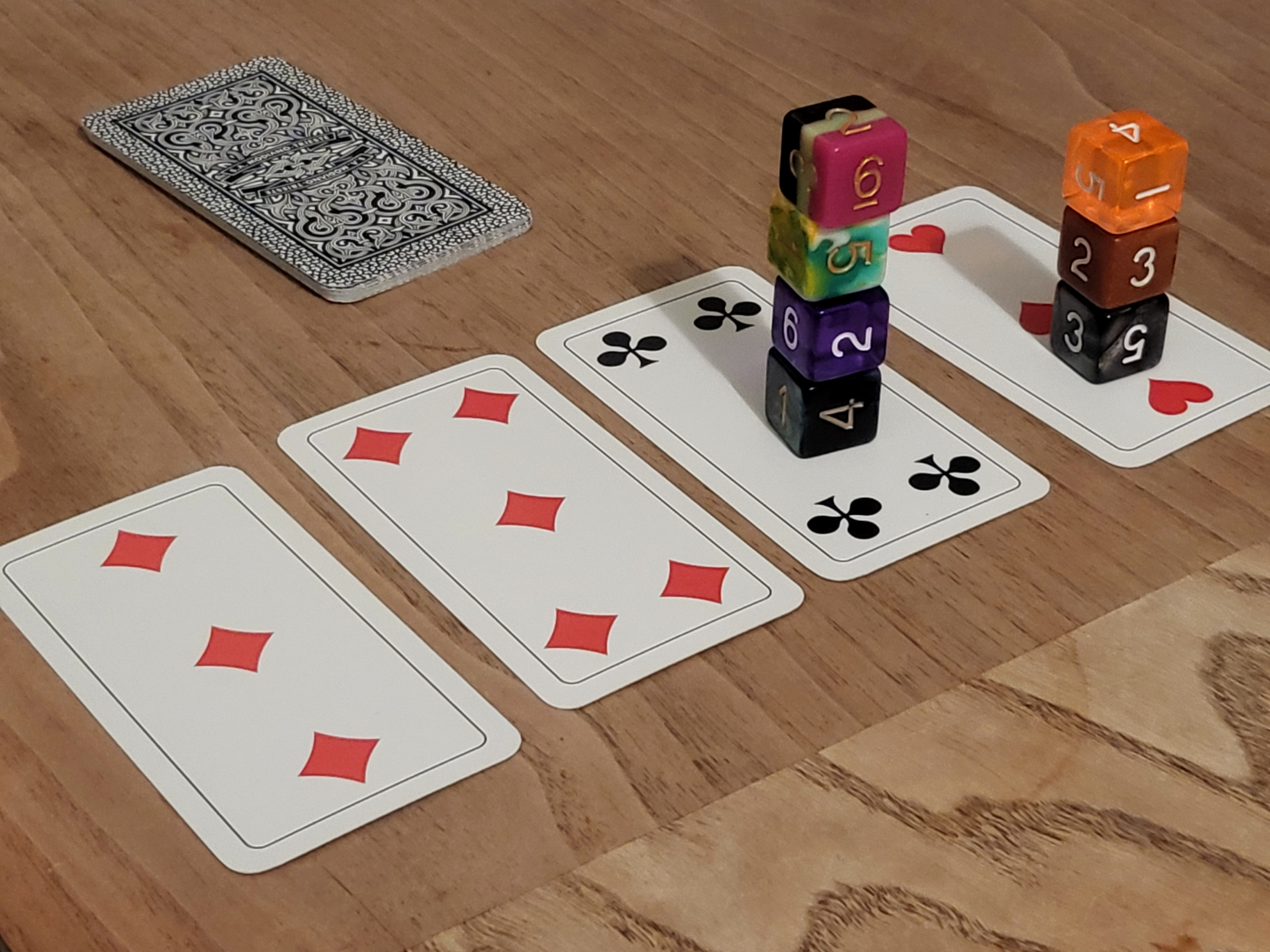Contract Bidding in Tarock

Don’t forget to subscribe!
Tricktaking is one of the older forms of gaming, and is having something of a resurgence in the modern board game world as of late. Before the article begins in earnest, let me give you a quick primer on tricktaking. It’s basically the core mechanic of many card games, new and old, that typically give each player a random hand of suited cards. From there, you play out a number of tricks, which follow this general flow:
- One player “leads the trick,” which means they play a card of their choice from their hand.
- Clockwise around the table, the other players each play a card to the trick, meaning they also play a card of their choice from their hand. Often this choice is limited by the suit of the lead card; in “must follow” games, you have to play a card of the same suit if you have one.
- A winner of the trick is determined once everyone has played a card. Typically, the winner is the player who played the highest card of the lead suit, unless somebody played a card from the “trump” suit, which is considered higher than any other suit
- The winner of the trick takes all the cards from the trick into a score pile, and leads the next trick
- Once all players are out of cards, there’s usually a scoring phase. Players score based on the tricks they’ve taken. This has taken just about every form imaginable; much of the variety in the genre is here.
Fun and interesting tricktaking games are being released all the time. The general vibe of the modern, packaged tricktaker is to take the standard formula of the must-follow tricktaking games of yore, like Hearts, Spades, Euchre, Pinochle, Bridge, Whist, etc, and twist some core piece of it to create something new. Here’s a glimpse at some of my favorites from what I’ve picked up over the years:

- Sail uses tricktaking to facilitate a 2-player cooperative game about sailing through danger on the high seas. It’s key to know how to win and lose tricks to navigate around the game’s obstacles.
- Roulette-Taking Game uses tricktaking to simulate betting on a game of roulette. Each space on the roulette wheel is a card, and playing tricks represents the ball spinning around the wheel as players place bets on where the ball will ultimately land, which is the number on the card that wins the final trick of the round.
- Aurum is a mostly “normal” bid-how-many-tricks-you-can-take style tricktaking game, but does some fun things around handing trump cards to the loser of a trick
- Politrickers attempts to simulate the power dynamics of a governing body, where players are sorted into two political parties and trying to pass laws for their team.
- TönTon is cute and small and plays around with different scoring conditions each round
- The Crew throws players into a “no communication cooperation” framework draped over some relatively standard tricktaking. It’s a little muddy in execution since it relies on an odd and poorly written campaign framework, but I like its ideas quite a lot
I like playing all of these, but none of them are my favorite tricktaking game. That honor lies with Slovenian Tarock, a classic old game that uses the Industrie und Glück tarock deck. Tarock decks share a common ancestor with the tarot cards everyone knows and loves, which were also used for tricktaking games before turning into a divination tool.
Slovenian Tarock (and many other Tarock games I haven’t played, like the Austrian Königrufen) is built on a mechanical foundation that I haven’t yet seen in any of the modern tricktakers: bidding for contracts. The only bidding I’ve seen is in line with what Aurum has--each player bids how many tricks they will win that hand, and scores extra points if they were correct.
Bidding for contracts in Slovenian Tarock is a much more involved affair. The 4 player game has 12 different contracts, each one harder to complete than the last. Once the cards are dealt, players will take turns bidding or passing. To bid, you just choose a higher contract than the last person. The contract that’s selected will set the scoring rules for the entire hand of tricks, so has a huge impact on the game.

The above reference sheets that I put together might seem like a lot to take in, but the contracts follow a similar format.
- Klop, the lowest contract, is also the weirdest. Basically everybody tries to avoid getting points if Klop is chosen, but it can only be bid in certain scenarios.
- Three, two, and one are all the same. If you win the bid with one of these, you’re just trying to win more than half of the card points (each card in the deck is worth a specific amount of points). Before play begins, you name a suit and the person with that suit’s King is on your team for the hand. The 3/2/1 just refers to how many cards you can exchange with the pile of extra cards in the middle (called the Talon).
- Solo three/two/one is the same, but you don’t get a partner. Solo without means you get no partner, and you get no extra cards.
- Beggar means you’ll take no tricks. Open beggar means you’ll take no tricks and you show your hand to the rest of the table.
- Color valat without means you’re going to win every tricks, but the tarock cards (similar to major arcana) are not trump for that round. Valat without means you’ll win every trick, even while contending with the tarocks as trump.
Okay maybe it’s still a lot to take in. Think of each round like its own mini game. The contracts are basically achievements you can get by completing certain tasks, but the bid is basically taking turns calling your shot at which achievement you’ll go for. Whoever calls the highest shot gets to actually go for it, and play proceeds. Once the bid is selected, the partner king is called, and cards are exchanged with the talon, a relatively normal tricktaking game proceeds. On your first hand, you’ll realize how trump-heavy the deck is: there are 22 tarock/trump cards but only 8 cards in each of the standard suits.
All of it is just good, crunchy fun. When someone wins the bid on one of the contracts with a partner, it adds great tension to each trick as you try to figure out who is on what team. Am I happy that you won the trick or is this going horribly? These contracts are incredibly potent for new modern tricktaking games, but also for rpgs. And thus, we arrive at…
Three Ideas That Haunt the Walrus
I’m going to try to hit this from three different angles. The first one is going to be a description of a tricktaking rpg that I’m actually thinking about making. For the other two, I think I’ll take a stroll outside the world of cards to see what else we might be able to cram a contract bidding subsystem into.
A Guilded Legacy
Players take on the roles of adventurer guilds trying to make a name for themselves over the course of generations. Every 20-30 years or so, an adventure opportunity arises that outshines all others, and that’s where we find ourselves.
A Guilded Legacy (extremely working title) mixes the card play of Slovenian Tarock with the adventures-over-time format of the video game Rogue Legacy. Each round of tricktaking represents a generation of adventurers; each bid for contracts represents the various guilds deciding who will go on the quest of a lifetime.
The various contracts in the game are all flavored like fantasy quests. The hardest one would be kill a dragon, while the easiest one would be killing rats in somebody’s basement. Once a quest has been successfully completed, it can never be bid for again. Players will bid like in Tarock, and the winner will assemble their party from their guild (and possibly one assisting guild) to complete the quest.
The hand then plays out, with each trick representing the triumphs and setbacks of the adventure. At the end, you count the points to see if it was an overall success. This raises the status of your guild, and maybe unlocks some stuff for roleplaying between hands.
Paranormal Investigators (The Return)
Last week I pitched a game about paranormal investigations. I want to return to the GMed version of that game to add in a little contract bidding. When the players look for a job, the GM will determine a new scary thing going on and the NPC factions will make bids on it. The contracts in this case would probably be largely mechanical - higher bids mean reduced pay and reduced resources to tackle the job. It’d be great if you had some stats on each NPC faction that indicate the types of jobs they’re interested in taking and how high they’ll bid to get them; that way each round the GM can just check what everyone would do without having to spend too much time on it.
If the players end up outbidding the NPCs, they have to complete that investigation. Succeeding would bring great reward, but failing would plummet their standing. Maybe if they lose a bid to an NPC faction, they’re forced to initiate a forged in the dark style downtime to bide their time until the next job comes up.
When the Devil Drives
Your goal is to make a pact with some vile demon and somehow come out ahead. Whoever is brave enough to make a pact with the vilest demon gets to actually go through with it. I’ve invented a weird dice stacking & card drawing push your luck mechanic here for the player who actually makes the deal, who we’ll call the signee.
While the signee is drawing cards and stacking dice, the other players will exert the power of the demon on the narrative. They’ll interpret the cards that get drawn as demonic trials, and flavor the dice stacking of the signee as their feeble attempts to circumvent the demon’s will. If the signee succeeds, they break free from the demon’s influence and get to keep whatever they got in the deal; if they fail, they’re dragged to hell where they probably belong.
Here’s how the game works:
- Grab a deck of cards. Set aside everything but 2-5.
- Players take turns bidding. A bid is a number of cards followed by a number of dice. The minimum card bid is 2, and the minimum dice is 5 (but you probably want more dice than that).
- To bid, you must either increase the number of cards, or decrease the number of dice (but you cannot go below 5).
- Once the bid is won, the player will grab the bid number of d6s and roll them, and then begin to confront the challenges.
- Draw a card from the deck. The number listed is how many dice you need to stack to beat the card. You cannot stack a die on top of a die with a lower value.
- You will always beat the first card. Of course you will, you’re pumped full of demon energy. Draw the next card.
- Begin stacking your remaining dice. If you’re out of dice, take the ones from the oldest tower and reroll them. If you can complete this stack, move to the next card until you’ve successfully confronted as many cards as you bid.

This is a weirdly fun little mini game; I keep setting my laptop aside to play a few rounds and see what’s possible. My high score so far is a 5-5 (5 cards, 5 dice), but it took a few tries to get there. You could do a lot with this demon game though! Maybe succeeding gives you powers that make future bids easier for you, so the power on offer gets revealed before the bidding starts. You could also steal this mechanic and throw it into any number of different games, but I’ll leave that as an exercise for the reader.
That’ll Do It
Thank you yet again for reading Haunted Walrus. I’ve been hard at work on Uneasy Lies the Head this week, so I’m glad I found some time to write this one out. This isn’t the last you’ll hear about tricktaking from me, my mind is cursed with cool ideas for tricktaking games. I have a solo tricktaking journaling game I’ll announce soon, and a multiplayer one you’ll just need to keep your eye out for. If you want more walrus, right in your inbox, make sure to subscribe to get these in your email.
Get Haunted Walrus
Haunted Walrus
Writings on board games, rpgs, and their mechanics
| Status | Released |
| Category | Physical game |
| Author | adambell |
| Genre | Role Playing |
| Tags | blog, Board Game, Game Design, newsletter |
More posts
- Worker Placement & Uneasy Lies the HeadApr 22, 2025
- Cooperative Resource GenerationFeb 06, 2025
- Let's Lie To Each Other For FunJan 23, 2025
- Don't Look At Your HandJan 16, 2025
- Welcome to Haunted Walrus!Jan 15, 2025
Comments
Log in with itch.io to leave a comment.
My partner loves trick taking games, I’ll keep an eye out for yours!
https://www.rascal.news/possible-worlds-games-will-publish-12-new-rpgs-by-2028/
Now that it's been announced I can say it'll be published by Possible Worlds!
Yo, congrats Adam!!
Magical girl game Sparkle Stars uses trick-taking for its basic scene rhythm